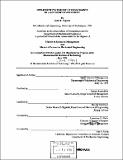Implementing theory of constraints in a job shop environment
Author(s)
Tagawa, John T. (John Tetsuo), 1972-
DownloadFull printable version (6.275Mb)
Advisor
Donald Rosenfield and Stanley Gershwin.
Terms of use
Metadata
Show full item recordAbstract
The Boeing Company is under performance pressures due to internal process performance and external cost pressures. The response has been a focus on manufacturing fundamentals to meet market demands on schedule and cost. Boeing has utilized Lean Manufacturing as the methodology for improving manufacturing. This thesis describes an implementation of Theory of Constraints in a job shop environment in a Boeing component manufacturing shop. Lean Manufacturing and Theory of Constraints are described and compared as methodologies for improving manufacturing systems. This thesis demonstrates that the two methodologies can be integrated in one manufacturing system. The TOC five-step continuous improvement methodology was utilized in the implementation as a framework for analysis. A process for identifying bottleneck operations in a job shop is detailed. The steps are to identify the process flows, determine constraints within the process flows and release material into the flowpath at the constraint production rate. It is probable that the actual constraint in the system will not be identifiable through data analysis, and methods for determining constraint operations through constraint engineering are described. An implementation of the drum-buffer-rope material control process is described in this thesis. To enable the implementation, a data management system was developed. The system utilizes the concept of critical ratio scheduling priority, a time buffer to protect bottlenecks from starvation and process flow to provide the necessary information for operating in a drum-buffer-rope pull environment. The drum-buffer-rope material control policy provides a method for controlling the WIP and cycle time in a factory within a MRP framework. The issues encountered in the implementation are detailed. These are related to information systems, organizational history, metrics, organizational culture and incumbent policies. These all provide challenges to implementation a TOC system and need to be managed properly.
Description
Thesis (S.M.)--Massachusetts Institute of Technology, Sloan School of Management; and, (S.M.)--Massachusetts Institute of Technology, Dept. of Mechanical Engineering, 1999. Includes bibliographical references (p. 91).
Date issued
1999Department
Massachusetts Institute of Technology. Department of Mechanical Engineering; Sloan School of ManagementPublisher
Massachusetts Institute of Technology
Keywords
Sloan School of Management, Mechanical Engineering